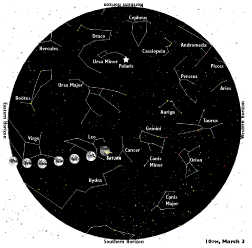|
|
 |
||||||
|
|||||||
A Total Eclipse of the MoonAnd we’ve got prime seats for this celestial spectacleThe moon waxes to full Saturday, March 3, when it intersects Earth’s own spherical shadow, resulting in the first total lunar eclipse in more than two and a half years. Those of us along Chesapeake Bay have prime viewing seats for a true celestial spectacle. A lunar eclipse, whether total or partial, happens when the earth passes directly between su The moon rises with sunset at 6:00, already fully eclipsed and remaining so for more than an hour. So close to the vernal equinox, this full moon rises due east and the sun sets due west. Despite its name, the fully eclipsed moon is visible once it’s escaped the glare of the horizon, shining an eerie reddish-orange, the result of earthshine — sunlight refracted from earth’s atmosphere that then strikes the moon’s surface. Totality lasts until 6:58pm, when the moon moves from the full circle of Earth’s shadow, called the umbra. As the moon moves into the penumbra — all the darkening we see in a partial lunar eclipse — the edges of the shadow begin to lighten. This stage of the eclipse lasts until 8:12pm, and by 8:50 the moon fully escapes our shadow. If weather spoils the show or you miss it, there are two others in the next year. For the first, August 28, we Baysiders must settle for the penumbra, as the moon sets just after entering the umbra. However, next year on February 20, everyone in North America will share prime seating. |
|||||||
|
|
|||||||
|
© COPYRIGHT 2007 by New Bay Enterprises, Inc. All rights reserved. |


 n and moon. The sunlight hitting the opposite side of earth creates a shadow, which in turn blots out the moon.
n and moon. The sunlight hitting the opposite side of earth creates a shadow, which in turn blots out the moon.